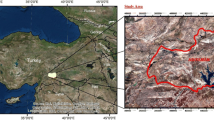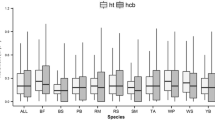Abstract
Key message
Crown variables and height can improve biomass predictions and may help to quantify how tree biomass is influenced by inter-tree competition (stand density, species composition), climate, edaphic conditions, and age.
Abstract
Tree biomass is influenced by tree age, stand structural characteristics, and climatic and edaphic site factors. However, most allometric equations for predicting tree biomass do not quantify these effects and when these characteristics are included as variables, they typically only reflect the average or current conditions even though tree allometry is the result of past growing conditions as well. An alternative to using site and stand characteristics is to use tree variables that have been influenced by site and stand structure for the whole lifetime of the tree. The objective of this study was to compare stem diameter-only equations that predict above-ground biomass or foliage mass with equations that also contain a climatic variable (aridity index) and stand variables, such as age and basal area (as a proxy for competition), or equations containing another tree size variable, such as crown diameter, crown length and tree height. This was done using 348 trees from 24 sites and 10 Eucalyptus species in southern Australia. Stand basal area and age were significant in 2 of 23 final equations and the aridity index was not significant in any equations. Adding another tree size variable to the diameter-only equations reduced the bias and increased the precision in 6 of the final equations. This study shows that the addition of crown variables (or height) to diameter-only biomass equations can quantify some of the effects that site and stand structural characteristics have on biomass. Variables such as crown diameter and height could also be useful because they are easier to measure accurately using remote sensing methods than stem diameters and related stand structural characteristics, such as basal area.





Similar content being viewed by others
References
António N, Tomé M, Tomé J, Soares P, Fontes L (2007) Effect of tree, stand, and site variables on the allometry of Eucalyptus globulus tree biomass. Can J For Res 37:895–906
Barbeito I, Collet C, Ningre F (2014) Crown responses to neighbor density and species identity in a young mixed deciduous stand Trees Structure and Function 28:1751–1765
Bartoń K (2016) Multi-Model Inference, R Package ‘MuMIn’ version 1.15.6
Bi H, Turner J, Lambert MJ (2004) Additive biomass equations for native eucalypt forest trees of temperate Australia trees—structure and function 18:467–479
Bond-Lamberty B, Wang C, Gower ST (2002) Above-ground and below-ground biomass and sapwood area allometric equations for six boreal tree species of Northern Manitoba. Can J For Res 32:1441–1450
Buchacher R, Ledermann T (2020) Interregional crown width models for individual trees growing in pure and mixed stands in Austria. Forests 11:114
Burkhart HE, Tomé M (2012) Tree weight and biomass estimation. In: Burkhart HE, Tomé M (eds) Modeling forest trees and stands. Springer, Dordrecht, pp 65–83
Cannell MGR (1984) Woody biomass of forest stands. For Ecol Manage 8:299–312
Chave J et al (2014) Improved allometric models to estimate the aboveground biomass of tropical trees. Glob Change Biol 20:3177–3190
Condés S, Sterba H (2005) Derivation of compatible crown width equations for some important tree species of Spain. For Ecol Manage 217:203–218
de Martonne E (1926) Une Nouvelle Fonction CIimatologique: L'Indice d'Aridite (A new ciimatological function: the aridity index). LaMétéorologie 2:449–458
del Río M, Bravo-Oviedo A, Ruiz-Peinado R, Condés S (2019) Tree allometry variation in response to intra- and inter-specific competitions. Trees 33:121–138
England JR et al. (2006) Water use, growth and carbon sequestration of environmental plantings
Forrester DI, Collopy JJ, Beadle CL, Baker TG (2012) Interactive effects of simultaneously applied thinning, pruning and fertiliser application treatments on growth, biomass production and crown architecture in a young Eucalyptus nitens plantation. For Ecol Manage 267:104–116. https://doi.org/10.1016/j.foreco.2011.11.039
Forrester DI, Benneter A, Bouriaud O, Bauhus J (2017a) Diversity and competition influence tree allometry—developing allometric functions for mixed-species forests. J Ecol 105:761–774
Forrester DI et al (2017b) Generalized biomass and leaf area allometric equations for European tree species incorporating stand structure, tree age and climate. For Ecol Manage 396:160–175
Forrester DI et al (2018) Effects of crown architecture and stand structure on light absorption in mixed and monospecific Fagus sylvatica and Pinus sylvestris forests along a productivity and climate gradient through Europe. J Ecol 106:746–760
Franceschini T, Schneider R (2014) Influence of shade tolerance and development stage on the allometry of ten temperate tree species. Oecologia 176:739–749
Goetz SJ et al (2009) Mapping and monitoring carbon stocks with satellite observations: a comparison of methods. Carbon Balance Manage 4:2
Goodman RC, Phillips OL, Baker TR (2014) The importance of crown dimensions to improve tropical tree biomass estimates. Ecol Appl 24:680–689
Grote R, Kraus D, Weis W, Ettl R, Göttlein A (in press) Dynamic coupling of allometric ratios to a process-based forest growth model for estimating the impacts of stand density changes. Forestry
Henry M, Picard N, Trotta C, Manlay RJ, Valentini R, Bernoux M, Saint-André L (2011) Estimating tree biomass of Sub-Saharan African forests: a review of available allometric equations. Silva Fennica 45:477–569
Jucker T et al (2017) Allometric equations for integrating remote sensing imagery into forest monitoring programs. Glob Change Biol 23:177–190
Ketterings QM, Coe R, Mv Noordwijk, Ambagau Y, Palm CA (2001) Reducing uncertainty in the use of allometric biomass equations for predicting above-ground tree biomass in mixed secondary forests. For Ecol Manage 146:199–209
Laclau J-P et al (2008) Mixed-species plantations of Acacia mangium and Eucalyptus grandis in Brazil 1. Growth dynamics and aboveground net primary production. For Ecol Manage 255:3905–3917
Lambert M-C, Ung C-H, Raulier F (2005) Canadian national tree aboveground biomass equations. Can J For Res 35:1996–2018
Ledermann T, Neumann M (2006) Biomass equations from data of old long-term experimental plots. Austrian J For Sci 123:47–64
Lines ER, Zavala MA, Purves DW, Coomes DA (2012) Predictable changes in aboveground allometry of trees along gradients of temperature, aridity and competition. Glob Ecol Biogeogr 21:1017–1028
Loomis RM, Phares RE, Crosby JS (1966) Estimating foliage and branchwood quantities in shortleaf pine. For Sci 12:30–39
Monserud RA, Marshall JD (1999) Allometric crown relations in three northern Idaho conifer species. Can J For Res 29:521–535
Montagu KD, Düttmer K, Barton CVM, Cowie AL (2005) Developing general allometric relationships for regional estimates of carbon sequestration—an example using Eucalyptus pilularis from seven contrasting sites. For Ecol Manage 204:113–127
Parresol B (1999) Assessing tree and stand biomass: a review with examples and critical comparisons. For Sci 45:573–593
Paul KI et al (2013) Development and testing of allometric equations for estimating above-ground biomass of mixed-species environmental plantings. For Ecol Manage 310:483–494
Paul KI et al (2016) Testing the generality of above-ground biomass allometry across plant functional types at the continent scale. Glob Change Biol 22:2106–2124
Paul KI, Larmour JS, Roxburgh SH, England JR, Davies MJ, Luck HD (2017) Measurements of stem diameter: implications for individual- and stand-level errors. Environ Monit Assess 189:416
Pérez-Cruzado C, Rodríguez-Soalleiro R (2011) Improvement in accuracy of aboveground biomass estimation in Eucalyptus nitens plantations: effect of bole sampling intensity and explanatory variables. For Ecol Manage 261:2016–2028
Pinkard EA, Neilsen WA (2003) Crown and stand characteristics of Eucalyptus nitens in response to initial spacing: implications for thinning. For Ecol Manage 172:215–227
Pinkard EA, Mohammed C, Beadle CL, Hall MF, Worledge D, Mollon A (2004) Growth responses, physiology and decay associated with pruning plantation-grown Eucalyptus globulus Labill. and E. nitens (Deane and Maiden) Maiden. For Ecol Manage 200:263–277
Pitt DG, Bell FW (2004) Effects of stand tending on the estimation of aboveground biomass of planted juvenile white spruce. Can J For Res 34:649–658
Porté A, Trichet P, Bert D, Loustau D (2002) Allometric relationships for branch and tree woody biomass of Maritime pine (Pinus pinaster Aït.). For Ecol Manage 158:71–83
Pretzsch H (2014) Canopy space filling and tree crown morphology in mixed-species stands compared with monocultures. For Ecol Manage 327:251–264
Raulier F, Ung CH, Ouellet D (1996) Influence of social status on crown geometry and volume increment in regular and irregular black spruce stands. Can J For Res 26:1742–1753
Saint-André L et al (2005) Age-related equations for above- and below-ground biomass of a Eucalyptus hybrid in Congo. For Ecol Manage 205:199–214
Sileshi GW (2014) A critical review of forest biomass estimation models, common mistakes and corrective measures. For Ecol Manage 329:237–264
Snowdon P (1991) A ratio estimator for bias correction in logarithmic regressions. Can J For Res 21:720–724
R Core Team (2019) R: A language and environment for statistical computing. R Foundation for Statistical Computing, Vienna, Austria. http://www.R-project.org/
Veiga PR (2008) Allometric biomass equations for plantations of Eucalyptus globulus and Eucalyptus nitens in Australia. Albert-Ludwigs University Freiburg, Faculty of Forest and Environmental Sciences
Wirth C, Schumacher J, Schulze E (2004) Generic biomass functions for Norway spruce in Central Europe—a meta-analysis approach toward prediction and uncertainty estimation. Tree Physiol 24:121–139
Xiang W et al (2011) General allometric equations and biomass allocation of Pinus massoniana trees on a regional scale in southern China. Ecol Res 26:697–711
Xiang W et al (2016) Species-specific and general allometric equations for estimating tree biomass components of subtropical forests in southern China. Eur J For Res 135:963–979
Xu T, Hutchinson M (2011) ANUCLIM Version 6.1 User Guide, Fenner School of Environment and Society. The Australian National University, Canberra
Zianis D, Muukkonen P, Mäkipää R, Mencuccini M (2005) Biomass and stem volume equations for tree species in Europe. Silva Fennica Monographs 4:63
Zuur AF, Ieno EN, Walker N, Saveliev AA, Smith GM (2009) Mixed effects models and extensions in ecology with R. Springer, Berlin
Acknowledgements
We acknowledge the many individuals who contributed to measurement, sampling and laboratory analysis including those from the Victorian Department of Environment, Land, Water and Planning, The University of Melbourne, The Western Australian Department of Conservation and Land Management and Hancock Victorian Plantations Pty Limited. We would also like to thank Jacqui England for providing the data from New South Wales and some of the data from Victoria. Thank you also to two anonymous reviewers who provided comments that improved the manuscript.
Author information
Authors and Affiliations
Contributions
DIF conceived and designed the study, analysed the data and wrote the first draft of the manuscript. All authors contributed data and to the writing of the manuscript.
Corresponding author
Ethics declarations
Ethics approval
All ethical standards were complied with.
Additional information
Communicated by Grams.
Publisher's Note
Springer Nature remains neutral with regard to jurisdictional claims in published maps and institutional affiliations.
Electronic supplementary material
Below is the link to the electronic supplementary material.
Rights and permissions
About this article
Cite this article
Forrester, D.I., Dumbrell, I.C., Elms, S.R. et al. Can crown variables increase the generality of individual tree biomass equations?. Trees 35, 15–26 (2021). https://doi.org/10.1007/s00468-020-02006-6
Received:
Accepted:
Published:
Issue Date:
DOI: https://doi.org/10.1007/s00468-020-02006-6




